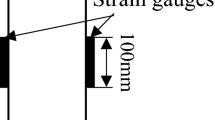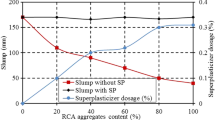Abstract
This study evaluates the possibility of measuring the damage of the recycled concrete. In this way, two conventional concretes with a w/c ratio of 0.55 and 0.65 were designed. Based on them, six recycled concretes with different percentages of replacement of natural coarse aggregates with recycled coarse aggregate (20, 50 and 100%) were obtained. To take into account the high absorption capacity of the recycled aggregates, before using them they were pre-wetted for 10 min. The results concluded that scalar damage mechanics (based on the variations of the elastic modulus) and volumetric strains curves can be use to quantify the damage of the recycled concrete. The results from both approaches indicated that the damage to concrete depended on the percentage of replacement, increasing with higher replacement percentages. Additionally, values of the damage, that are quantified using the critical stress and according to the scalar damage mechanics, are given.














Similar content being viewed by others
References
Etxeberria M, Vázquez E, Marí A (2009) Microstructure analysis of hardened recycled aggregate concrete. Mag Concr Res 58:683–690
Poon CS, Shui ZH, Lam L (2004) Effect of microstructure of ITZ on compressive strength of concrete. Constr Build Mater 18:461–468
Tam VWY, Gao XF, Tam CM (2005) Microstructural analysis of recycled aggregate concrete produced from two-stage mixing approach. Cem Concr Res 35:1195–1203
Sanchez de Juan M, Gutiérrez PA (2009) Study on the influence of attached mortar content on the properties of recycled concrete aggregate. Constr Build Mater 23:872–877
Sukontasukkul P, Nimityongskul P, Mindess S (2004) Effect of loading rate on damage of concrete. Cem Concr Res 34:2127–2134
Dyuch K, Szerszen M, Destrebecq JF (1994) Experimental investigation of the fatigue strength of plain concrete under high compressive loading. Mater Struct 27:505–509
Akçao T, Tokyay M, Çelik T (2002) Effect of coarse aggregate size on interfacial cracking under uniaxial compression. Mater Lett 57:828–833
Cervenka V, Bouska P (1986) Automated testing of concrete compressive properties. In Wieringa H (ed) Experimental stress analysis, Amsterdam, Netherlands, pp 11–15, ISBN 9024733472
Shah SP, Chandra S (1968) Critical stress, volume change, and microcracking of concrete. ACI J 65:770–781
Zheng D, Li Q, Wang L (2005) A microscopic approach to rate effect on compressive strength of concrete. Eng Fract Mech 72:2316–2327
Giaccio G, Rodríguez de Sensale G, Zerbino R(2007) Failure mechanism of normal and high-strength concrete with rice-husk ash. Cem Concr Comp 29(8):566–574
Ranjith PG, Jasinge D, Song JY, Choi SK (2008) A study of the effect of displacement rate and moisture content on the mechanical properties of concrete: use of acoustic emission. Mech Mater 40:453–469
Nixon PJ (1987) Recycled concrete as an aggregate for concrete—a review. Mater Struct 65:371–378
Etxeberria M, Vázquez E, Marí A, Barra M (2007) Influence of amount of recycled coarse aggregates and production process on properties of recycled aggregate concrete. Cem Concr Res 37:735–742. doi:10.1016/j.cemconres.2007.02.002
Hansen TC, Narud H (1983) Strength of recycled concrete made from crushed concrete coarse aggregate. Concr Int 5:79–83
Katz A (2003) Properties of concrete made with recycled aggregate from partially hydrated old concrete. Cem Concr Res 33:703–711
Rao A, Jha KN, Misra S (2007) Use of aggregates from recycled construction and demolition waste in concrete. Resour Conserv Recycl 50(1):71–81
EHE08. Spanish Structural Concrete Code (2008). Publicaciones del Ministerio de Fomento. Secretaría General Técnica
Faury J (1958). Le b′eton, 3.`eme edition, Dunod Paris
Ravindrarajah RS, Loo YH, Tam CT (1987) Recycled concrete as fine and coarse aggregate in concrete. Mag Concr Res 39:214–220
Xiao J, Li J, Ch Zhang (2005) Mechanical properties of recycled aggregate concrete under uniaxial loading. Cem Concr Res 35:1187–1194
Berndt ML (2009) Properties of sustainable concrete containing fly ash, slag and recycled concrete aggregate. Constr Build Mater 23:2606–2613
Poon CS, Shui ZH, Lam L, Fok H, Kou SC (2004) Influence of moisture states of natural and recycled aggregates on the slump and compressive strength of concrete. Cem Concr Res 34:31–36
Casuccio M, Torrijos MC, Giaccio G, Zerbino R (2008) Failure mechanism of recycled aggregate concrete. Constr Build Mater 22:1500–1506
Nealen A, Schenk S (1998) The influence of recycled aggregate core moisture on freshly mixed and hardened concrete properties. Darmstadt Concrete 13. http://www.b-i-m.de/public/tudmassiv/dacon13nealenschenk.htm
Sagoe-Crentsil KK, Browm T, Taylor AH (2001) Performance of concrete made with commercially produced coarse recycled concrete aggregate. Cem Concr Res 31:707–712
Rühl M (1992) Water absorption capacity of recycled demolition rubbish. In: Darmstadt concrete 97, Ausgabe 12
González-Fonteboa B, Martínez-Abella F, Carro López D, Seara-Paz S (2011) Stress-strain relationship in axial compression for concrete using recycled saturated coarse aggregate. Constr Build Mater 25:2335–2342
de Oliveira MB, Vazquez E (1996) The influence of retained moisture in aggregate from recycling on the properties of new hardened concrete. Waste Manag 16:113–117
Mukai T, Kikuchi M, Ishikawa N (1978) Study on the properties of concrete containing recycled concrete aggregate. Cement Association of Japan, 32nd review
Ravindrarajah RS, Tam CT (1985) Properties of concrete made with crushed concrete as coarse aggregate. Mag Concr Res 37(130):29–38
Hendriks ChF, Pietersen HS, Fraay AFA (1998) Recycling of buildings and demolition waste—an Integrated approach. In: Dhir RK, Henderson NA, Limbachiya MC (eds) Sustainable construction: use of recycled concrete aggregate. University of Dundee, London, pp 419–432, ISBN 0-7277-2726-5
de Brito J, Alves F (2010) Concrete with recycled aggregates: the Portuguese experimental research. Mater Struct 43:35–51. doi:10.1617/s11527-010-9595-7
Hansen TC, Schulz RR, Hendricks ChF, Molin C, Lauritzen EK (1992) Recycling of demolished concrete and masonry. Report of Technical Committee 37-DCR, RILEM, UK
Topçu IB, Günçan NF (1995) Using waste concrete as aggregate. Cem Concr Res 25:1385–1390
Corinaldesi V (2010) Mechanical and elastic behaviour of concretes made of recycled-concrete coarse aggregates. Constr Build Mater 24(9):1616–1620
Acknowledgments
This study is part of the project entitled “3.2-358/2005/3-B: An experimental study on the use of RCDs in recycled concrete used in structural applications (RECNHOR)”, financed by the Spanish Environmental Ministry. In order to go on with this line of research, a new project has been given to the group. It belongs to the program CENIT (Spanish Ministry of Industry) and is called “Clean, efficient and nice construction along its life cycle (CLEAM)”.
Author information
Authors and Affiliations
Corresponding author
Rights and permissions
About this article
Cite this article
González-Fonteboa, B., Martínez-Abella, F., Eiras-López, J. et al. Effect of recycled coarse aggregate on damage of recycled concrete. Mater Struct 44, 1759–1771 (2011). https://doi.org/10.1617/s11527-011-9736-7
Received:
Accepted:
Published:
Issue Date:
DOI: https://doi.org/10.1617/s11527-011-9736-7




